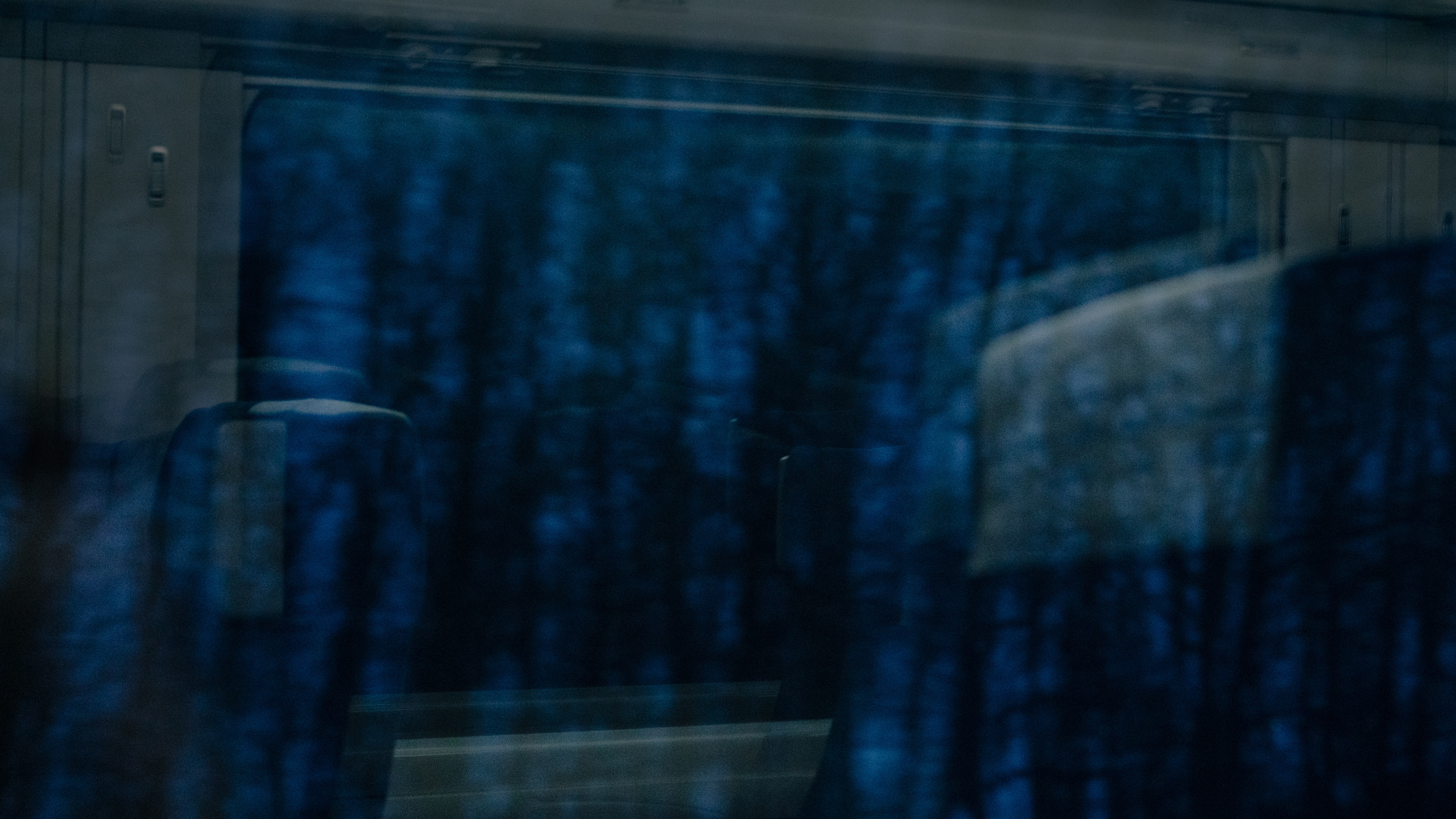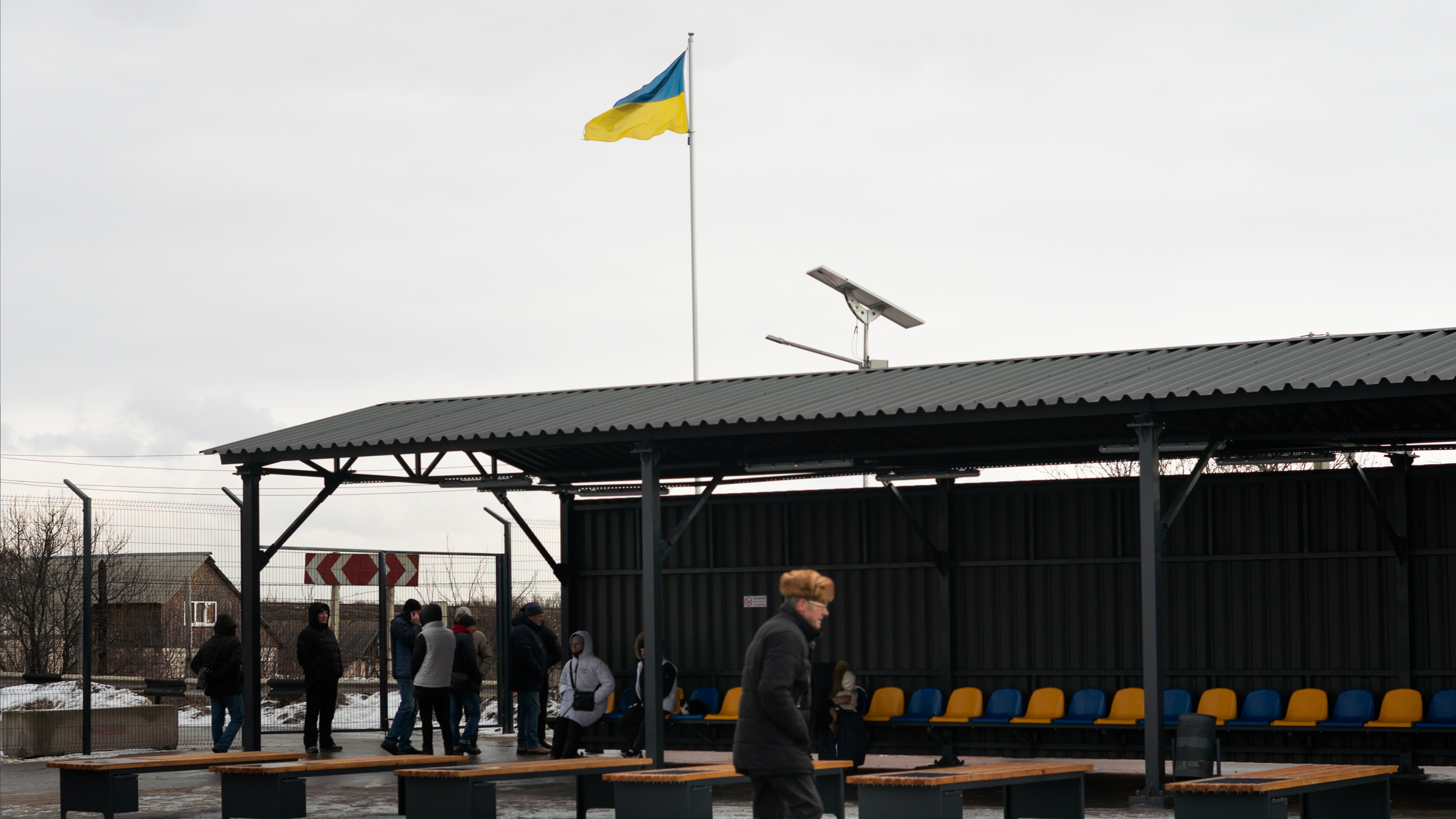DONBAS, Ukraine — An estimated 100,000 Russian troops are amassed at the border of Ukraine, surrounding the country from three sides like a horseshoe. The bulk of those troops are to the far east, hard up against the Russian border. It's an area of the country called Donbas, where life has already been turned upside down by war with Russia.

Trees reflected in a window on a train from Kyiv to Slovyansk.
Tensions have been simmering there since 2014, when Russia-backed separatists moved in and declared breakaway republics. They have been fighting ever since.

A man walks through a tunnel with street art in Slovyansk, a small city that was overtaken by separatists in 2014. It was the first city they took, and they held it for three months before the Ukrainian army came in and took it back.
Now, people here face the prospect of being caught in the middle of what the White House is warning could be the largest invasion since World War II.

Ukrainian flags are reflected in a puddle at the crossing to the occupied territory in Stanytsia Luhanska.
To get to Donbas, we hop a highspeed train from Kyiv. Our journey takes us past vast grain fields and flat stretches of land, covered in deep, deep snow. The area is known for coal mining and farming – although these days, it's mostly known for conflict.

A Soviet star can be seen on a statue across the street from the crossing into occupied territories.
Our first stop is Slovyansk, a small city that was overtaken by separatists in 2014. It was the first city they took, and they held it for three months before the Ukrainian army came in and took it back. The fighting was fierce.

The Kyiv train station in January.
We meet Vita Milko, 41, who is out with her husband watching their young daughter play in the snow. She tells us she's proud to be Ukrainian, and she knows how close her life was to completely changing had the separatists not been run out eight years ago.

People exit the train at a station on the way to Slovyansk.
"I try not to think about it," she says, looking at her daughter. "I'm happy this city was freed. I would like all other cities to be freed as well."

Vitalii Milko (left) stands with his wife Vita, their daughter Milana, 4, and a stray dog in the central square in Slovyansk.
Those "other cities" Vita is talking about lie even farther east. The Kyiv government calls them "temporarily occupied territories." The territories were seized in 2014, just like Slovyansk, but the Ukraine army never won them back. Russia has never formally annexed them, either. So the people who live there are in limbo – cut off from Ukraine, cut off from Russia, cut off from the world.

The central square in Slovyansk where a statue of Lenin was removed in 2015.
To get there, or as close as we can get, we hire a driver to take us another three hours further east, through multiple police and military checkpoints, to Stanytsia Luhanska.

A shop that sells food and drinks outside the train station in Slovyansk.
This is the only crossing right now between the rest of Ukraine and the northernmost occupied territory, manned by guards on both sides who check documents. People cross out from the occupied territory to buy certain Ukrainian goods, get cash from ATMs, collect government pensions or visit family and friends.

A chemical factory that makes fertilizer in Eastern Ukraine on the way to Stanitsya Luhanska.
Just a few blocks from the crossing is the village, with row after row of single-story homes and a small central park. But nearly everyone left during the war, and many died.

Top: A man walks towards the border with the northernmost separatist region in Eastern Ukraine. Bottom left: People guarding the border walk across some ice. Bottom right: A group heads towards the crossing with the separatist region. People cross out from the occupied territory to buy certain Ukrainian goods, get cash from ATMs, collect government pensions or visit family and friends.
We meet 66-year-old Davydovych, who doesn't want to give his last name, for fear of retribution. Speaking freely inside the occupied territories is dangerous, but even here, near the border outside, is risky. He has lived here his whole life and stayed after the war.

A home in Stanytsia Luhanska that now stands vacant like many others on the street. Numerous buildings like this have clear signs of bullet and mortar holes. Nearly everyone has left the area.
Davydovych tells us that just this morning he heard shooting nearby. He doesn't know from which direction, or who was doing the shooting. He sighs in a way that suggests he's given up trying to keep track.
We ask him what he'll do if more fighting comes, if Russia invades and the war starts again.
He shrugs and drops his arms to his sides. "I don't know, I'm just fed up," he says, and his eyes start to fill with tears. "I am broken inside."
For now, diplomatic efforts to resolve the standoff continue. But for many in this part of the world, the threat of war has become a way of life.
9(MDA4NjUyNDQ3MDEzMjMyODAxMTA3N2QwYw004))





